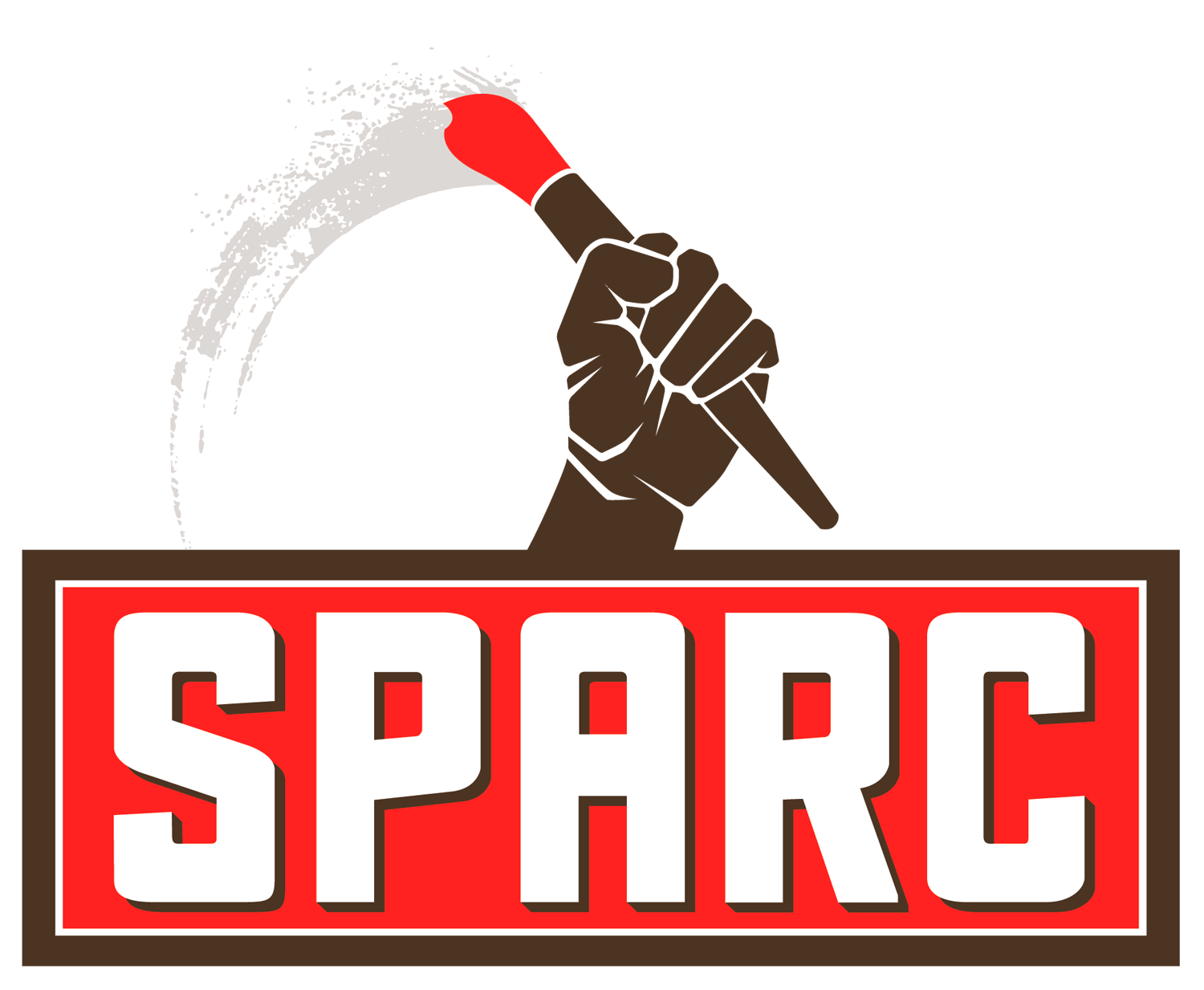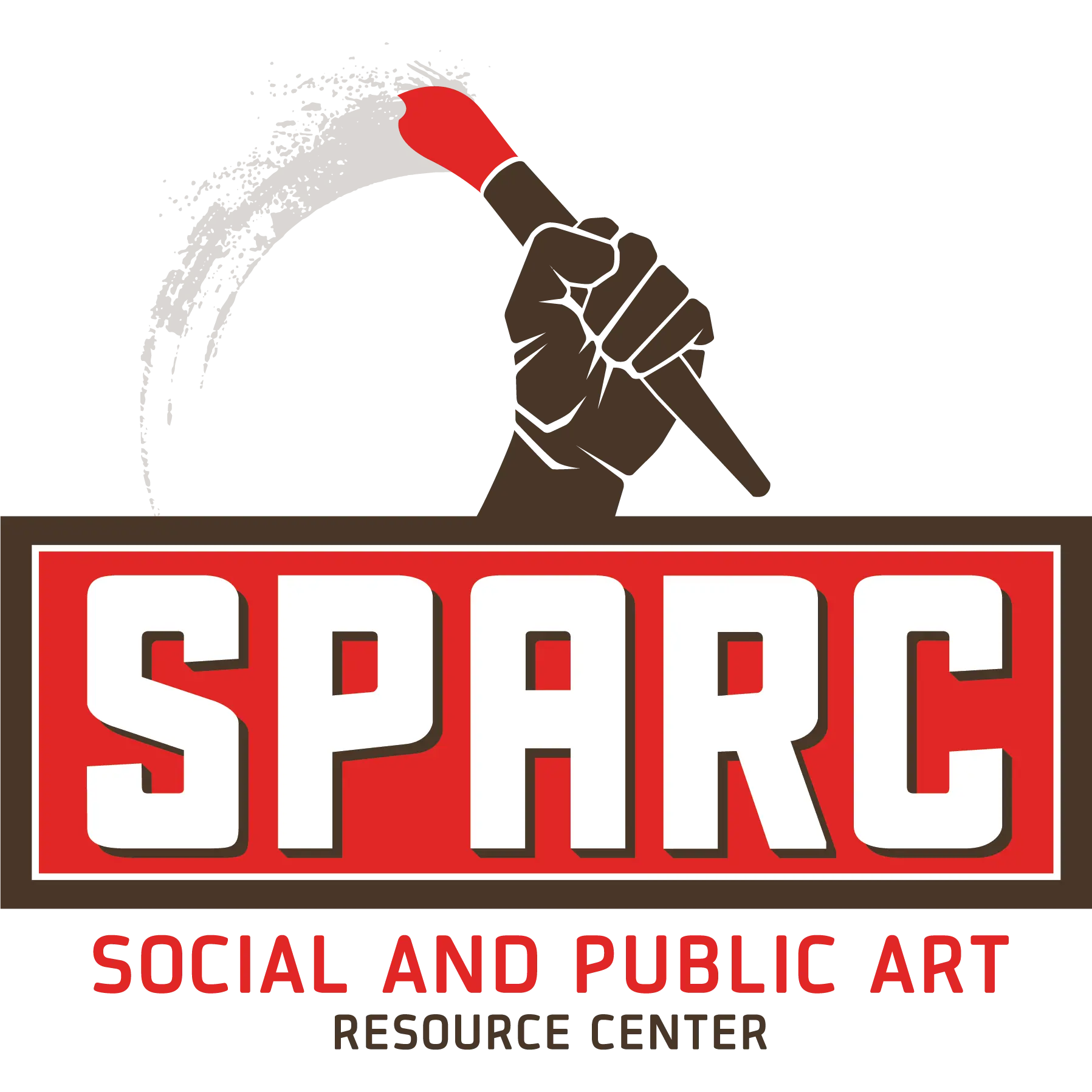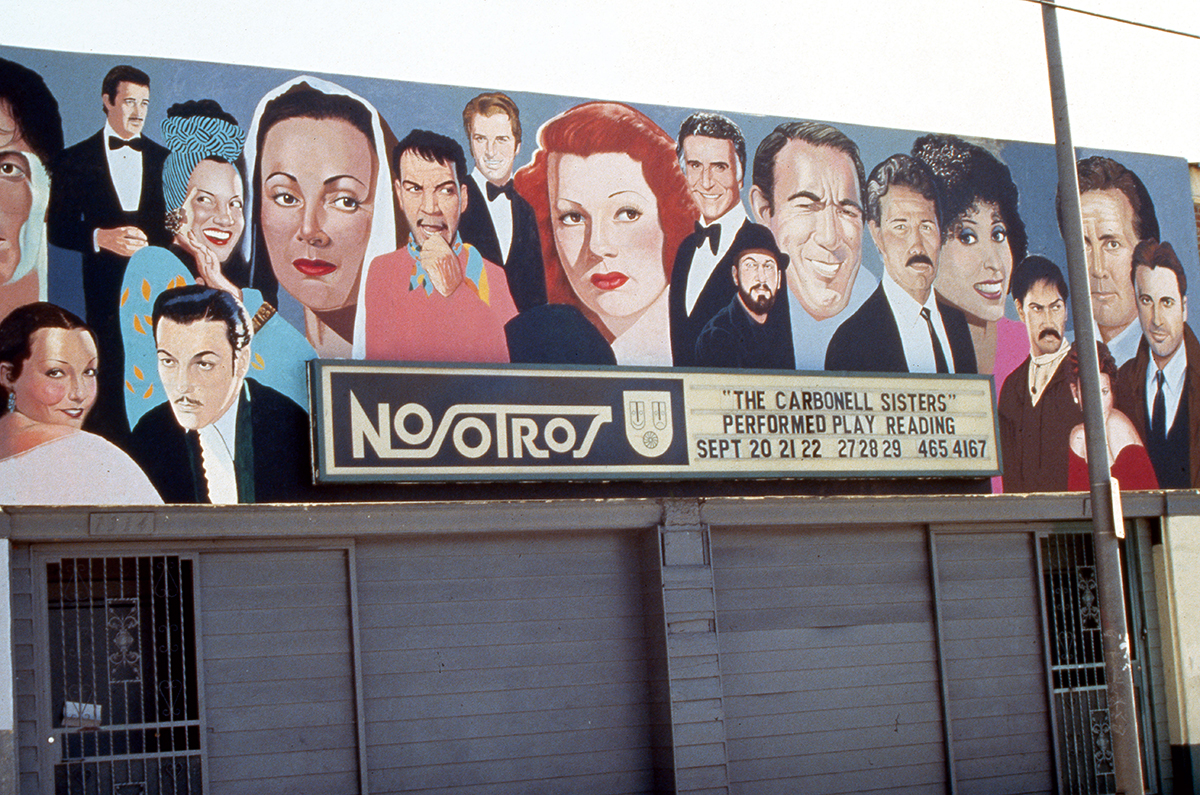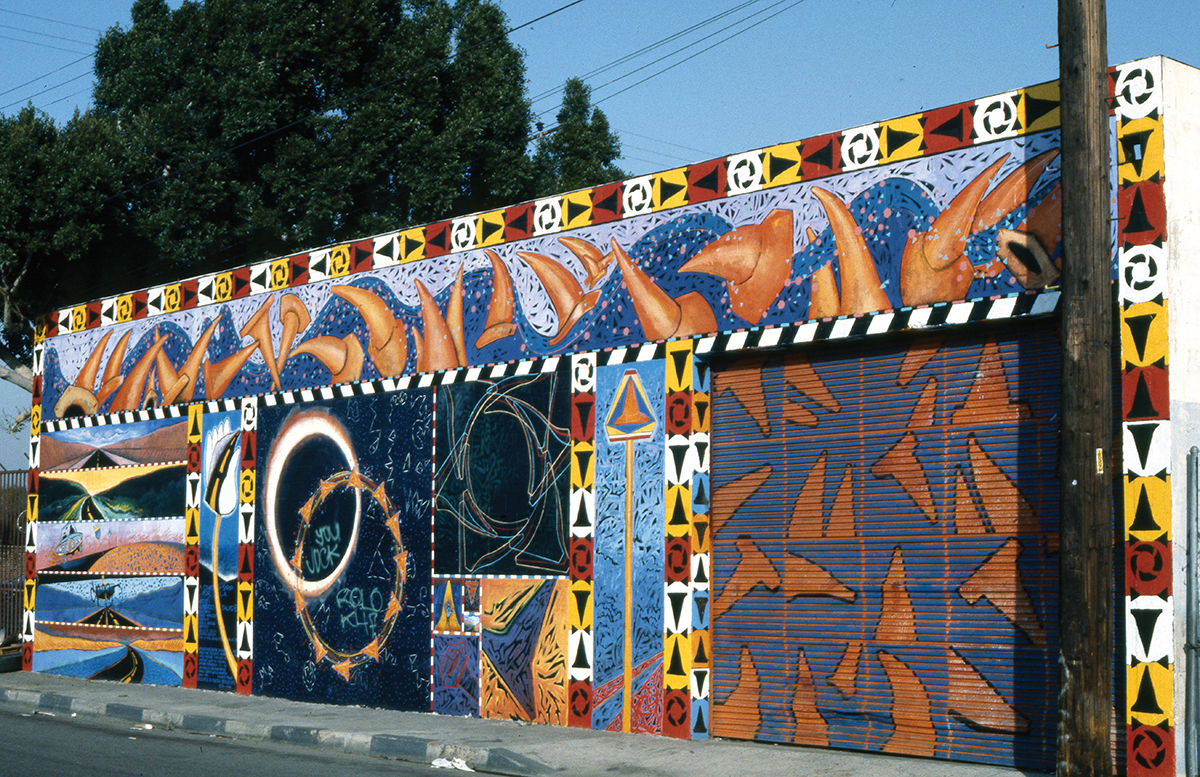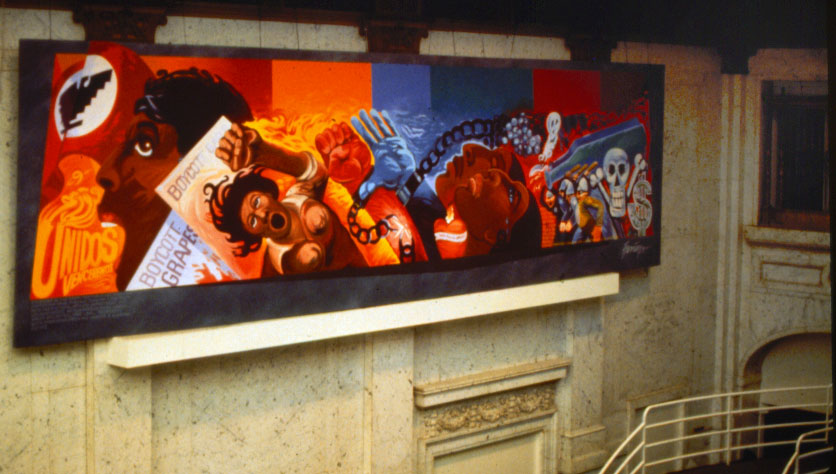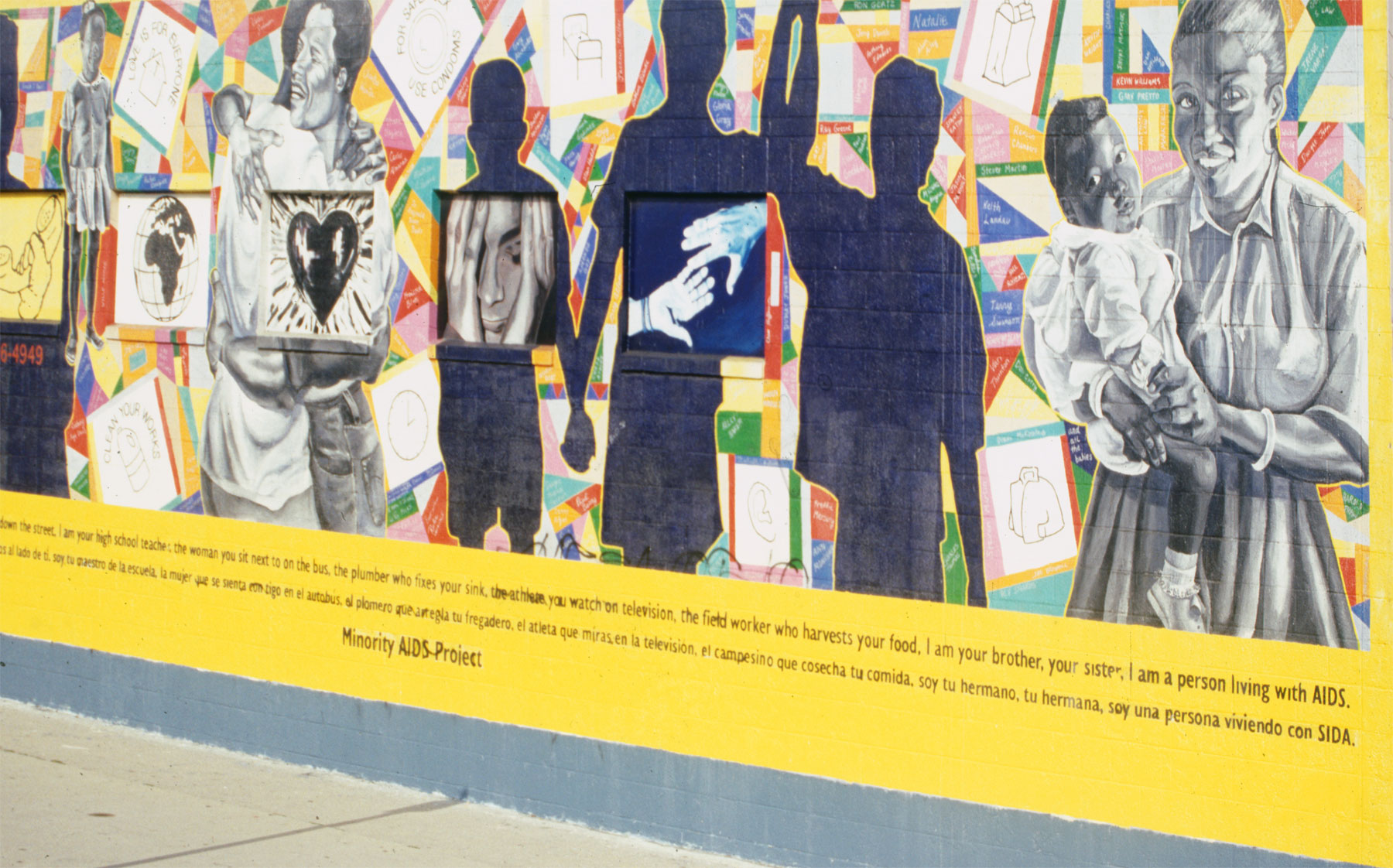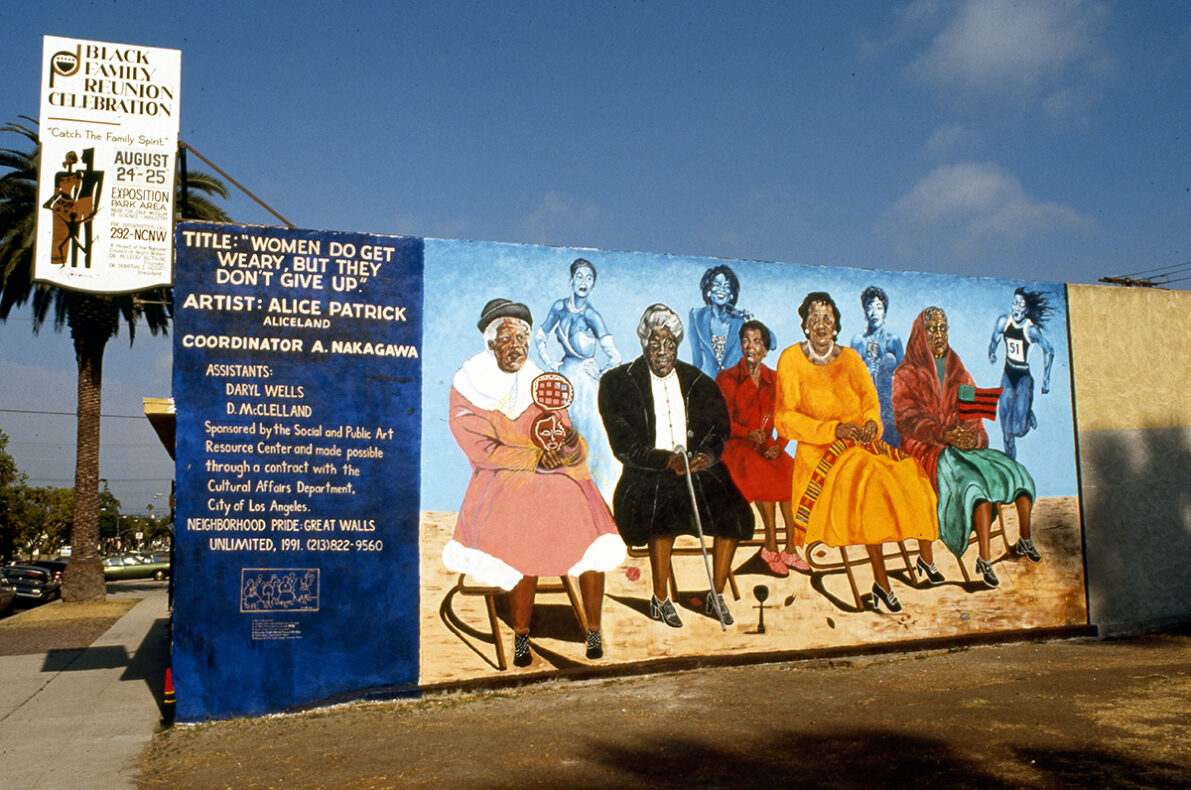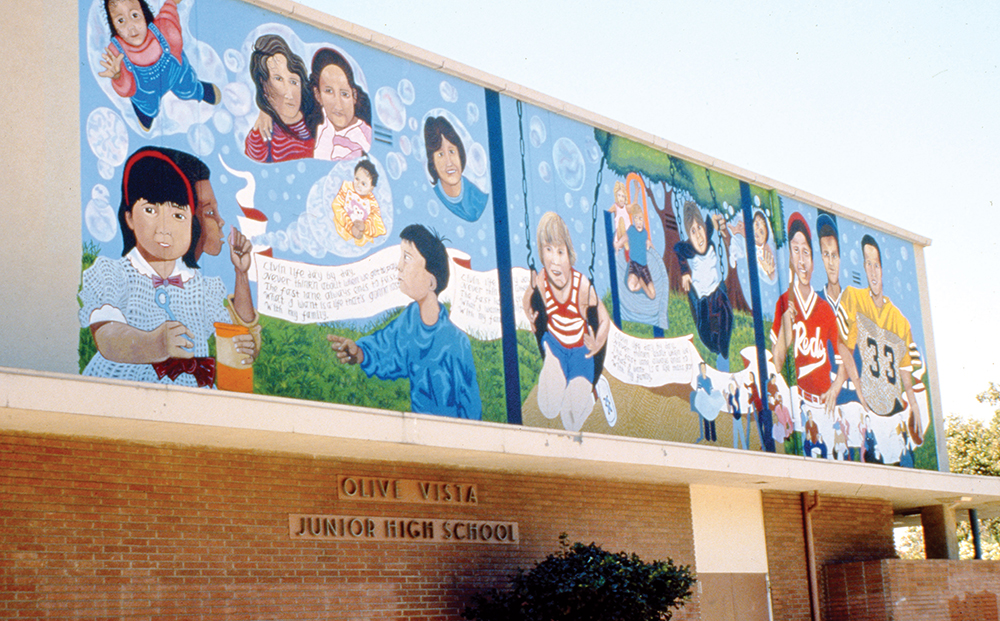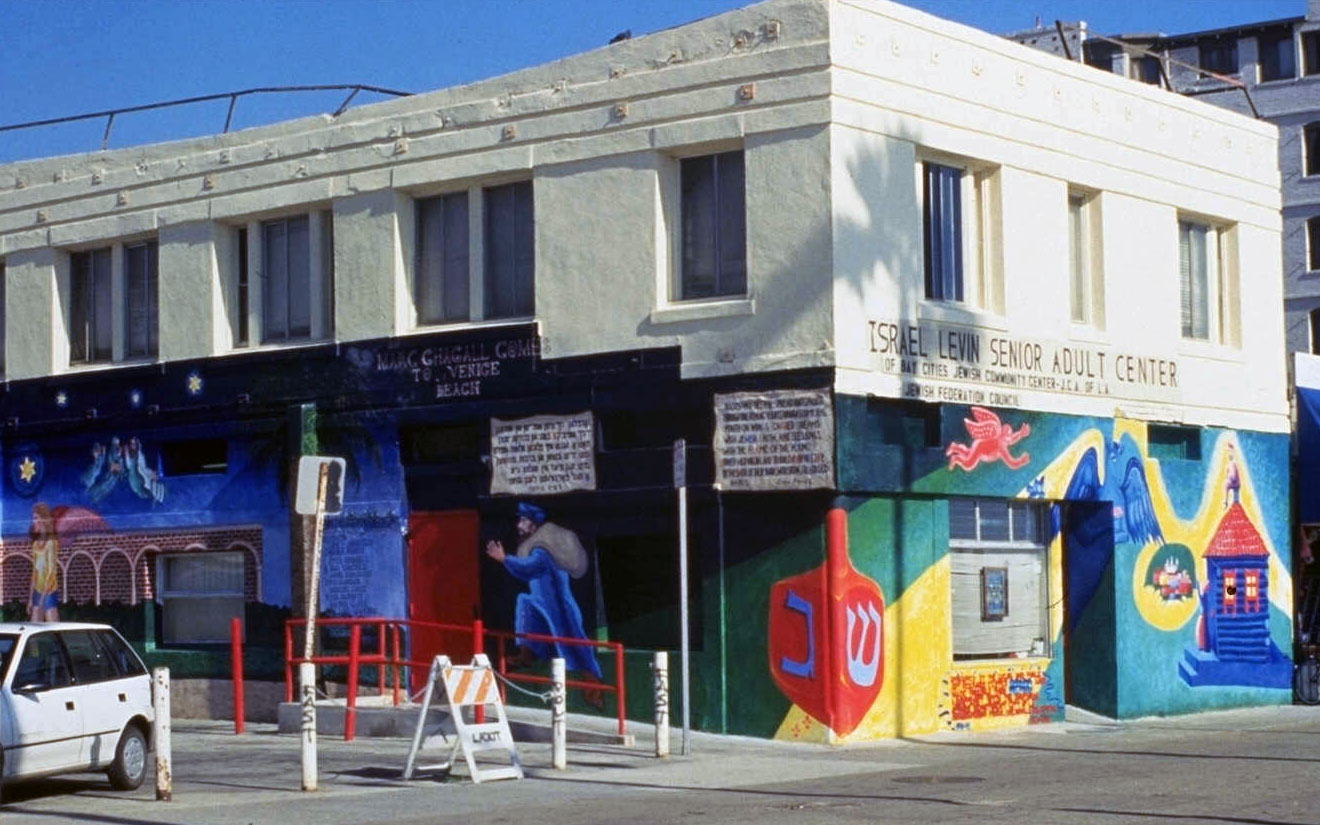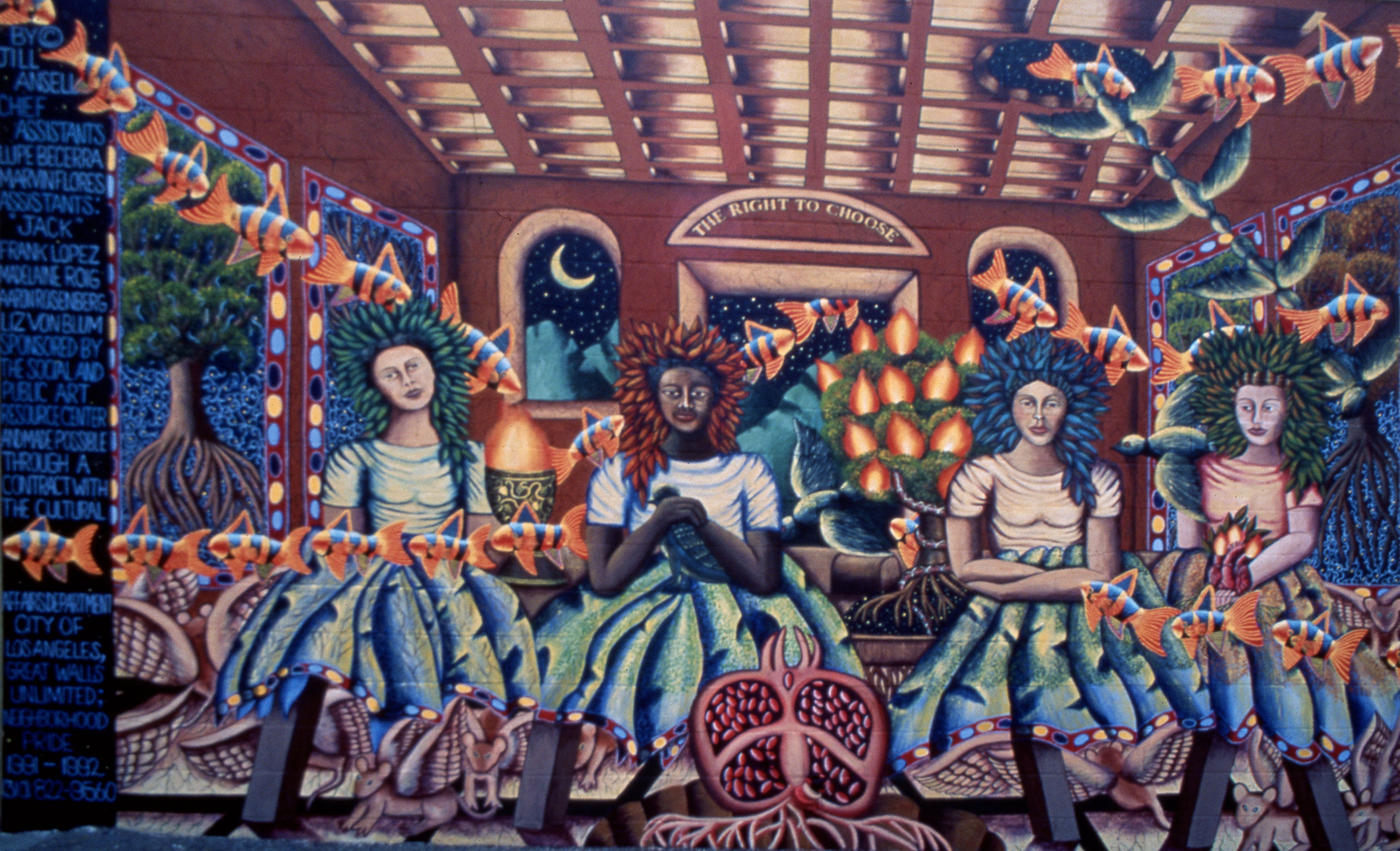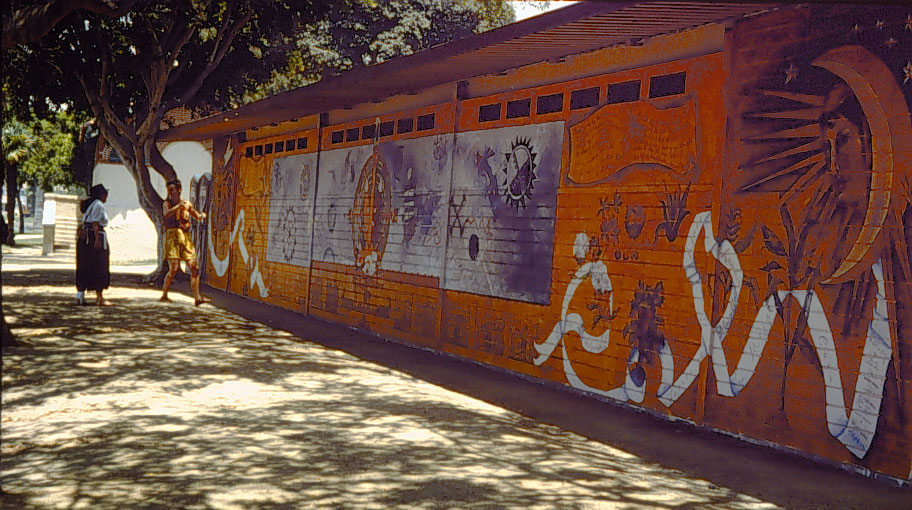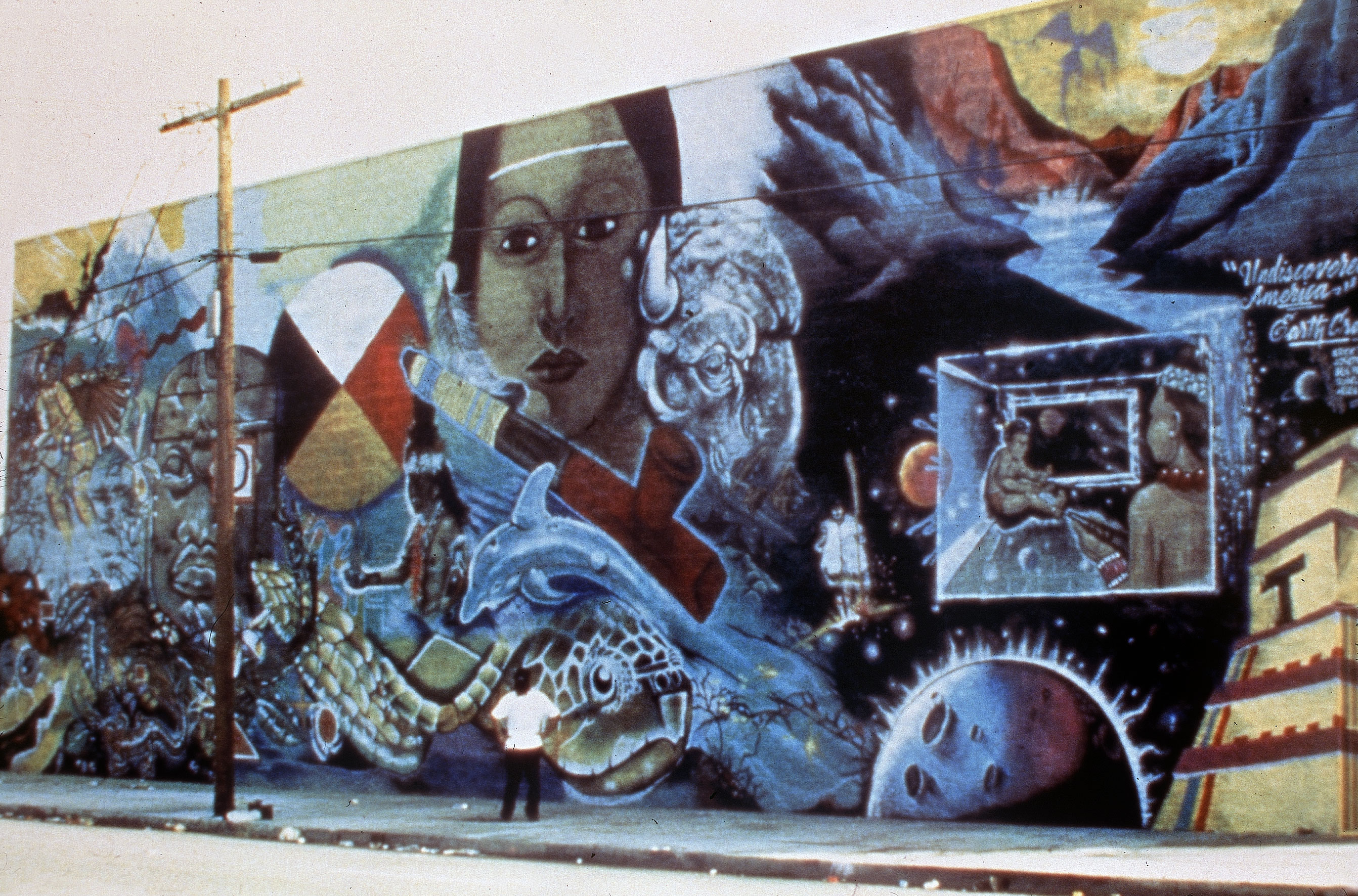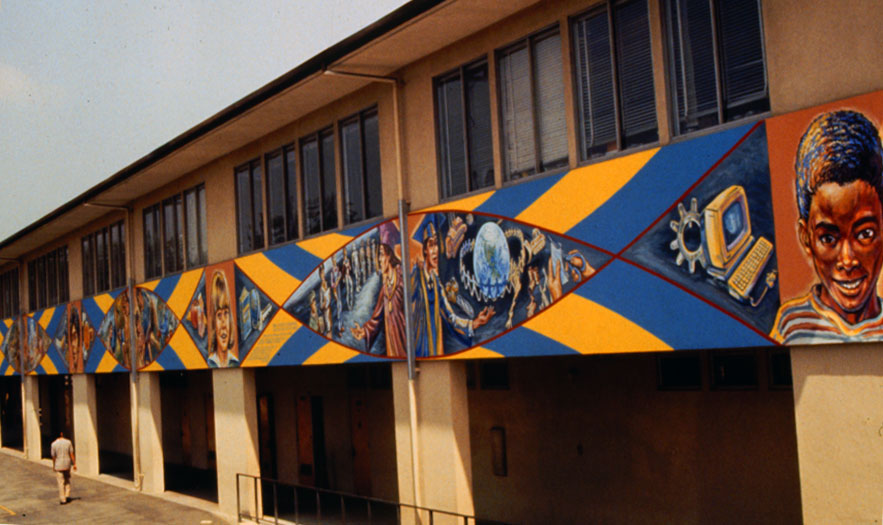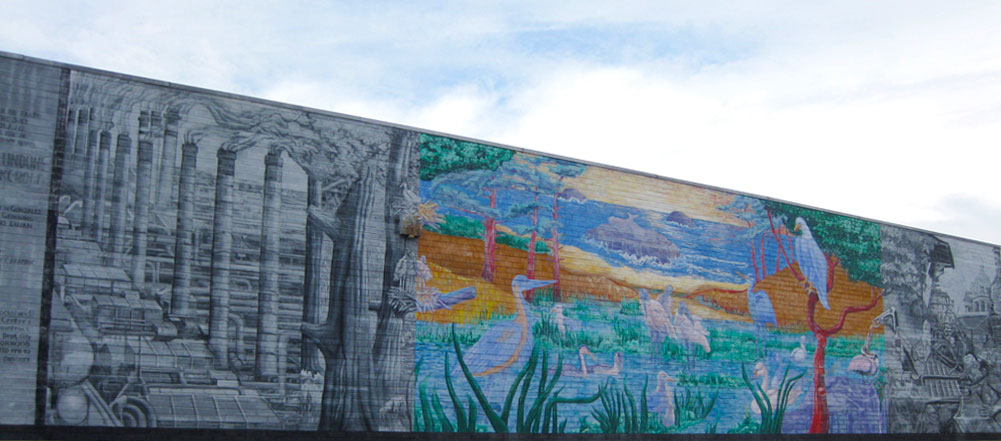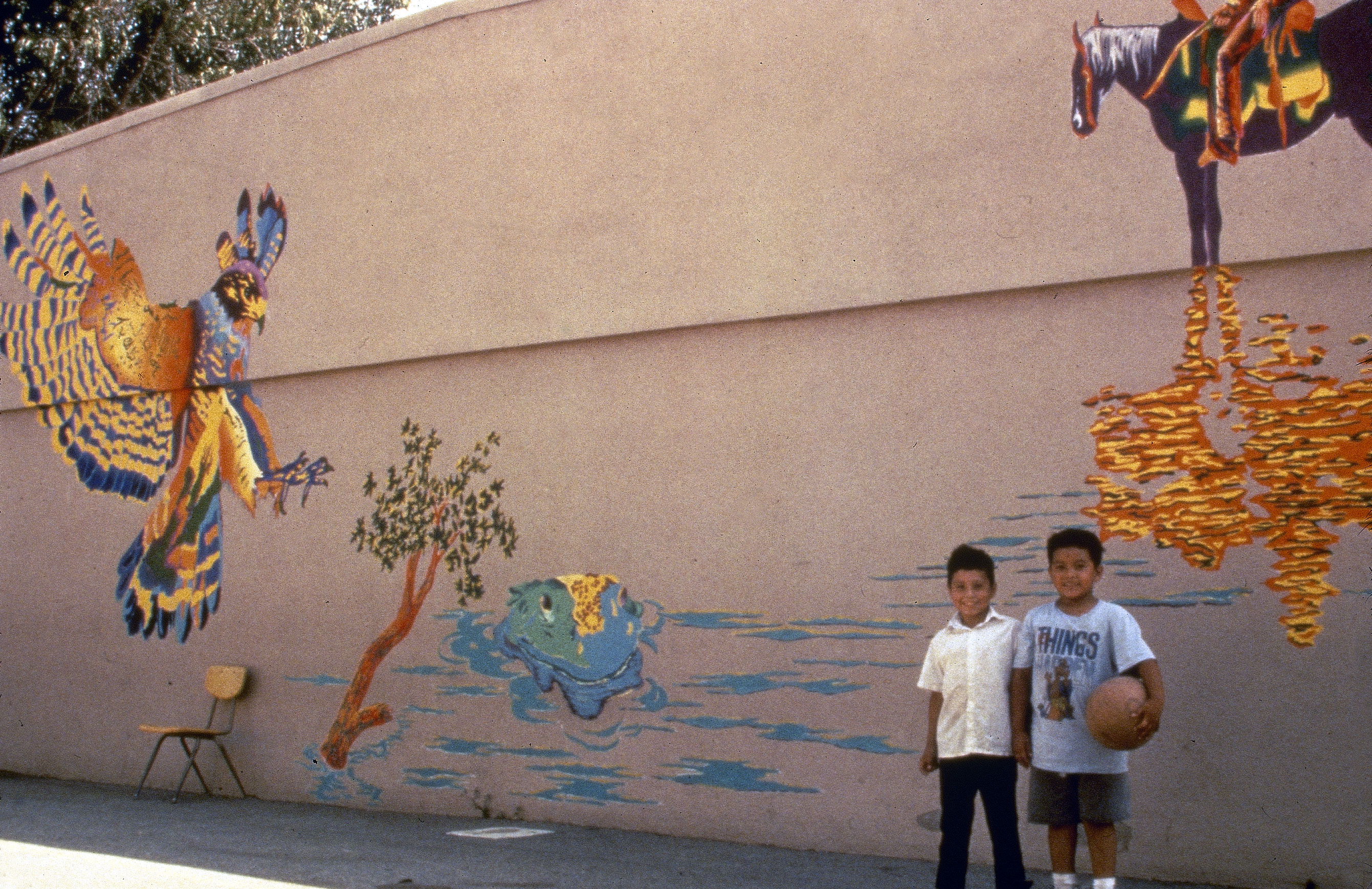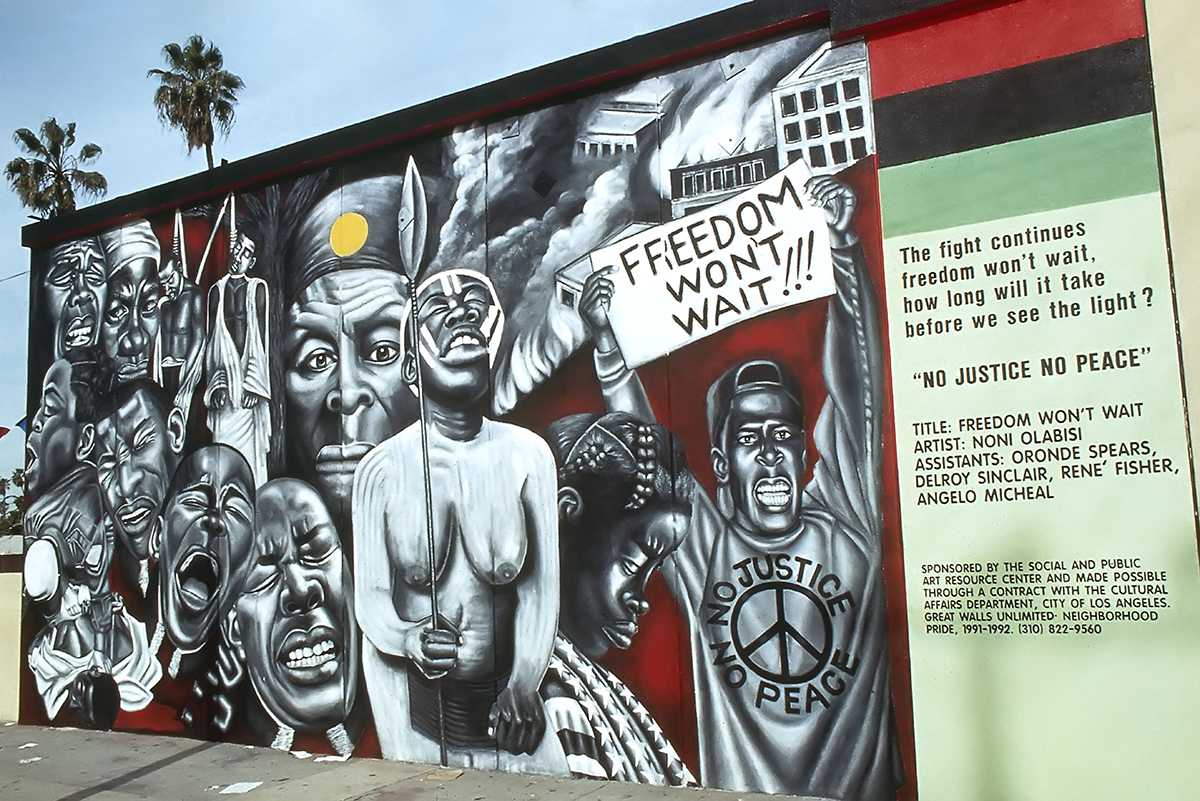Neighborhood Pride
Hispanic Hollywood (1990) by Ignacio Gomez
| Location | Nosotros Theatre, 1314 N Wilton Pl, Los Angeles, CA 90028 |
| Artist | Ignacio Gomez |
| Subject | |
| Status | This mural has been completely whitewashed. |
The Conic Strip of Los Angeles (1991) by Roberto Salas
| Location | 1744 W Washington Blvd, Los Angeles, CA 90007 |
| Artist | Roberto Salas is a site-specific public artist whose community art projects, murals and sculptural commissions can be found nationally and internationally. He is an Indo-Hispano educator who grew up in the desert border city of El Paso, and he has since relocated to the coastal border city of San Diego. |
| Subject | The orange traffic cone, a ubiquitous symbol for the car culture that Los Angeles is built around, is re-examine in a graphic form. |
| Status | The building that housed the mural has been torn down, and the mural destroyed. |
No Compre Vino Gallo (1990) by Willie Herron
| Location | In Herron’s Storage (Portable Mural), Restoration of a Carlos Almaraz Mural |
| Artist | Willie Herron III grew up in East Los Angeles, and has been long active in the Chicano art movement. He rose to prominence in the early 1970s with the “blood and guts and fists” style he uses to portray the barrio where he was raised and began drawing and painting. He had the ability to cope in a community where he sometimes had to “dodge bullets between brushstrokes”. “I began painting murals in Los Angeles with a conscious attempt at representing contemporary issues that confront the people of those communities in which my murals are located” –Willie F. Herron |
| Subject | For the 1990-91 Neighborhood Pride Program, as a tribute to Carlos Almaraz and to the historic struggle of the United Farm workers’ Union, Herron recreated No Compren Vino Gallo, one of the most artistically significant Chicano murals. The artist includes elements of Siqueiros’s mural imagery, and portrays the UFW boycott of Gallo wine; a company that uses grapes picked by workers who suffered horrible working conditions. The mural commemorates the UFW’s struggle for social justice and against dehumanizing agribusiness and corporate greed. The mural was exhibited at the Latino Lab at the former Los Angeles Theater Center (LATC) in 1991 until it was moved because the LATC closure. |
| Status |
Love is for Everyone (1991) by Mary Linn-Hughes and Reginald Zachary
| Location | Minority AIDS Project Building, 5149 W Jefferson Blvd, Los Angeles, CA 90016 |
| Artist | Based in Huntington Beach, Linn-Hughes has spearheaded various art therapy projects. Among them, running a self-portrait photography workshop for people with AIDS and being the artist in residence at Orangewood Children’s Home. |
| Subject | Text on the mural: I am your co-worker, I am the married couple who live down the street, I am your high school teacher, the woman you sit next to on the bus, the plumber who fixes your sink, the athlete you watch of television, the field worker who harvests your food, I am your brother, your sister, I am a person living with AIDS. The same text repeats in Spanish. |
| Status | The mural has suffered slight delimitation and graffiti damage. |
Women Do Get Weary, But They Don’t give Up (1991) by Alice Patrick
| Location | National Council of Negro Women, 3720 W 54th St, Los Angeles, CA 90043 |
| Artist | Patrick studied at The Art Center of Design, The Otis Art Institute, and privately with Anton Sabas. |
| Subject | |
| Status | The mural was restored in 2012 by the artist, with the help of the SPARC Mural Rescue Program. |
Your Kids, My Kids (1991) by Manuel Velazquez
| Location | Olive Vista School, 14600 Tyler St, Sylmar, CA 91342 |
| Artist | Velasquez attended CSU Northridge, where he helped set up a landmark gang peace conference that brought 1,500 gang members to campus to sign a peace treaty that lasted 18 months. He worked for ten years as a counselor for Community Youth Gang Services. Involving gang youth in painting murals was an important part of his job; the process helped them communicate with him and with each other. |
| Subject | Three talented young athletes, victims of gang violence, are memorialized. To their left are are local neighborhood children playing. This mural project developed out of the artist’s anguish of over more than a dozen violent deaths, during a two year period, of youth he personally knew. The project was fully embraced by the families of those killed. |
| Status | The mural has suffered surface cracking, delamination, and graffiti damage.The artist attempted to restore the mural without adequate scaffolding and supplies. |
Marc Chagall Comes Back to Venice Beach (1991) by Christina Shlesinger
| Location | Israel Levin Center, Venice Broadwalk, Ocean Front Walk, Venice, CA 90291 |
| Artist | Christina Schlesinger was born in 1946 into the family of renowned historian and Harvard professor Arthur M. Schlesinger Sr. and Arthur M. Schlesinger Jr., who was the White House Aid to President John F. Kennedy and advisor to President Lyndon B. Johnson. She lived in Cambridge, Mass. And Washington, D.C., earned a B.A. from Radcliffe College in 1966, and studied at Cal Arts in 1971. In Los Angeles she was involved in the Citywide Mural Project, and in 1976 she helped found SPARC, with Judith F. Baca and Donna Deitch. She also studied ink and brush painting at the Zhejiang Academy of Fine Arts in Hangzhou, China. The winner of numerous grants and fellowships, she also worked for some years with New York City youngsters designing and painting murals in high schools. “I grew up on the East Coast in a family of artists and celebrated historians. I graduated from Harvard, moving to Los Angeles in the ’70s. There I painted murals and co-founded SPARC (The Social and Public Art Resource Center) with Judy Baca.”-Christina Schlesinger |
| Subject | The mural employs imagery from the Russian-Jewish painter Marc Chagall superimposed onto the Venice Beachfront. At the far left a rabbi is holding a torah on which is written, in Hebrew, the 5th Commandment, “Honor Thy Father and Thy Mother.” A Chagall bird leaps from the flames and leads the viewer’s eye into the main section of the mural, where various characters and images from Chagall are placed onto the Venice Beach and boardwalk. A rabbi with a small rabbi standing on top of his head, indicates the many generations of teachers in Jewish history. Next to the fiddler on the roof the viewer sees the non-Chagallian character, an angel on roller blades representing contemporary Venice beach. He stands beneath a candelabrum of seven candles, referring to the seven-branched menorah and the extensive use of light in Jewish religion and culture. At the other end of the mural is a poem about overcoming obstacles called “Roots.” It is written by 95-year-old Dora Bayrack. |
| Status | Disaster struck in 1994 when the Northridge earthquake caused so much damage to the Israel Levin Center that the entire building had to be re-plastered. In the process, the mural was destroyed. Distressed at the loss of the mural the center’s senior citizens appealed and petitioned to the Jewish Federation to sponsor a restoration effort. The mural has suffered graffiti, delamination and fading damage. |
Immaculate Perception (1991) by Jill Ansell
| Location | Planned Parenthood, 1920 Marengo St, Los Angeles, CA 90033 |
| Artist | Ansell is a Taos painter and muralist whose work has been exhibited and published extensively. She has been working in the field of public mural projects since 1978. |
| Subject | The mural depicts four women of varying ethnicities seated in an architectural setting referencing a Renaissance use of perspective. The piece is dedicated to the strength of women. In the front is a large pomegranate, the fruit of knowledge (used in the Persephone myth and thought to be the fruit picked by Eve). The title of the piece refers to the nickname for Plato’s theory of knowledge–Plato believed that all knowledge came from past lives and from one’s knowledge of The Forms. |
| Status | This mural has slightly faded. |
El Arbol de Medio (1991) by Barbara Benish-Kalná
| Location | Echo Park Avenue & Park Avenue, Echo Park |
| Artist | Benish-Kalná is an American artist who moved to the Czech Republic after completing a year as a Fulbright Scholar. She has shown at P.S.1 Museum in New York, UNESCO Headquarters in Paris and the Venice Biennial. Her work is represented in collections around the world, including the Getty Museum in Los Angeles. |
| Subject | The title of the mural translates to “A Tree in the Middle Place.” The theme comes from he Mayan myth of the Ceiba Tree, in which the central world tree connects the planets of the Underworld (Xibalba), the terrestrial realm and the skies. . At the top center is the Virgen of Guadalupe, which was suggested by a member of the community during one of the community meetings for the project. The mural plays tribute to the agricultural contributions the Americas have given to the rest of the world. It is fashioned after an indigenous art form and includes pre-Columbian motifs and references to native plants and vegetables of the Americas |
| Status | This mural has been completely destroyed. |
Undiscovered America (1992) by Earth Crew
| Location | 843 East 4th St, Los Angeles, CA 90013 |
| Artist | Brought together in 1989 by the death of a friend (by random gang violence), Earth Crew is a groups of more then 20 youths. They began to create murals as a way to promote non-violence. |
| Subject | The subject of the piece are the little-known and under-appreciated achievements of Native American nations from Alaska to Argentina. The mural features a medicine wheel in the center. |
| Status | This mural has faded and suffered graffiti damage. |
Take the Future in Your Hands (1992) by East Los Angeles Streetscapers
| Location | Haddon Elementary School, 10085 Haddon Ave, Pacoima, CA 91331 |
| Artist | In 1975 David Botello and Wayne Healy founded Los Dos Streetscapers. Soon other artists such as George Yepes and Rudy Caldero began working with them; consequently, they changed their name to East Los Streetscapers. While other artists have come and gone, Botello and Healy have remained the core of the team. I addition to their many local murals they have done projects in Houston, St. Louis and Bellingham, WA. Botello and Healy did their first mural on dinosaurs in the third grade, but soon afterwards Botello’s family moved a mile away to City Terrace from their East Los Angeles neighborhood. It wasn’t until they were adults and both were doing murals on their own, that they met again and decided to renew their collaboration. |
| Subject | The mural contains portraits of four children for different ethnicities. Between them are large scenes of cultural history, family, education and careers. In addition to smaller images of nutritional food, different kinds of athletic balls and technological tools. The artists made a conscious effort to incorporate the architectural elements of the windows and columns into the composition of the mural. |
| Status | The mural has suffered from slight fading. |
The Chai Undone (1992) by Eva Cockcroft
| Location | 10534 W Pico Blvd, Los Angeles, CA 90064 |
| Artist | A writer and art historian, as well as an artist, Cockroft painted and/or directed the painting of more than 25 murals–primarily in New York and New Jersey, before moving to Southern California in 1989. Cockroft wrote extensively on murals, especially on their relationship to progressive movements for social change. She was the co-author of Toward A People’s Art: The Contemporary Mural Movement, published in 1977. She and Holly Barnet-Sanchez edited Signs From The Heart: California Chicano Murals,published by SPARC in 1990. Her paintings and drawings have been exhibited in numerous solo and group shows on both the East and West Coasts. She studied at Cornell University (B.A. in English) and Rutgers University (M.A.in Art History). Cockroft passed-away from cancer in 1999. |
| Subject | The theme is the imminent destruction of the wetlands. The mural is divided into three sections. In the large central portions is a vibrantly colored march full of birds. The two side panels are black-and-white images of industrial development that are closing in on the panel, a visual metaphor for the effects of this development on the environment. |
| Status | This mural has slightly faded. |
Untitled (1992) by Bernard Heloua
| Location | Norwood Elementary, 2020 Oak St, Los Angeles, CA 90007 |
| Artist | Heloua-Grimaldi is a French muralist and painter with a degree in civil engineering and architecture.He came with a strong background in working with community-based projects, and most of his previous murals are an average of 6 to 8 stories high. Many of his murals were organized by Painting with Youth, a project involving young people in the suburbs of Paris who design and execute outdoor works. |
| Subject | This project is not a mural, but several. Heloua likes to incorporate the architectural design of the building, including fences and sidewalks in his murals. The theme of the mural is translation of integration. The wall itself means the existing: the country, the land where the community lives. The colors mean the people, the most beautiful expression of life. Heloua was originally scheduled to paint only one mural, a globe-like depiction of land and sea masses, which upon closer inspection is actually the stoic face of an American Indian. But the artist accepted the commission without seeing the site, where he mural was on the back wall of the school’s cafeteria. “When I painted the first mural, I found it so hidden and alone, that I thought it wouldn’t change anything,” said Heloua. “So I suggested to paint everything and they agreed.” Along with a portrait of Sitting Bull in the cafeteria and various painted embellishments, Heloua-Grimaldi decorated the elementary school with images sacred to Native Americans. He was helped throughout the four week period by students. |
| Status | The mural has faded and suffered from delamination. |
Freedom Won’t Wait (1992) by noni Olabasi
| Location | 1815 W 54th St, Los Angeles, CA 90062 |
| Artist | Olabasi is a muralist that deals with civil rights in his work. At the time of this mural’s creation he was working as a barber across the street at La Rutan. |
| Subject | The mural was commissioned as a response to the community uprising in lat April 1992 int the aftermath of the legal verdict acquitting the police officers who beat-up African-American motorist Rodney King. Images of lynching and police brutality are intertwined. |
| Status | The red sections of the mural are slightly fading. |
